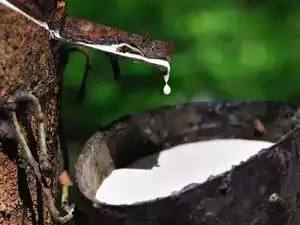Context:
Recently, the Union Minister of State for Agriculture & Farmers’ Welfare discussed the government’s measures to regulate the natural rubber market in India during a Lok Sabha session.
More on the news
- In Lok Sabha, the Minister was asked about
- The details of action taken by the Government to protect natural rubber farmers, particularly in safeguarding the price of natural rubber against imports;
- whether the Government is ready to provide Minimum Support Price (MSP) for natural rubber
- Natural Rubber is not included in the items for which Minimum Support Price (MSP) is notified.
Key Government Initiatives to Protect Domestic Farmers:
- Import Duty Increase: The government raised the duty on imported dry rubber from “20% or Rs. 30 per kg, whichever is lower” to “25% or Rs. 30 per kg, whichever is lower,” effective April 30, 2015.
- Advance Licensing Scheme: The period for utilizing imported dry rubber under the advance licensing scheme was reduced from 18 months to 6 months in January 2015.
- Port Restrictions: In January 2016, the government restricted the ports of entry for natural rubber imports to Chennai and NhavaSheva.
- Custom Duty on Compound Rubber: In the Union Budget 2023-24, the customs duty on compound rubber was increased from 10% to 25%.
- Government Policy: In March 2019, the Department of Commerce introduced the National Rubber Policy, focusing on new planting, processing, marketing, and addressing labor shortages in the rubber sector
Agricultural Classification of Natural Rubber:
- Natural Rubber cannot be treated as an agricultural product. Though Natural Rubber cultivation may be treated as an agricultural activity, the income from its post-cultivation practices may not be treated as an agricultural income as it is exclusively used as a raw material for industrial purposes.
- In most existing Free Trade Agreements (FTAs) and Regional Trade Agreements (RTAs), Natural Rubber is included in exclusion lists to protect the interest of rubber growers.
About Natural Rubber:
- It is a polyterpene composed of 500 to 5,000 isoprene units.
- It is obtained from the latex of several tropical trees.
- The main source of natural rubber is the tropical tree name Hevea brasiliensis.
- The first commercial Hevea plantations were established at Thattekadu in Kerala in 1902.
- Kerala is the top rubber-producing state in India, Accounting for about 74% of the country’s total rubber output
Agro-Climate Condition:
- Soil: Rubber plants thrive in well-drained and well-weathered soils, such as lateritic, alluvial, and sedimentary types.
- Rainfall: At least 100 rainy days each year are necessary for optimal growth.
- Temperature: Ideal temperatures for rubber cultivation range from 20 to 34°C.
- Humidity: It should be around 80%, with 2000 hours of sunshine and an absence of strong winds.
Minimum Support Prices (MSPs):
- The government of India uses MSP as a type of market intervention to protect farmers from sudden drops in farm prices.
- The government fixes Minimum Support Prices (MSP) for 22 mandated agricultural crops and Fair & Remunerative Price (FRP) for sugarcane based on the recommendations of the Commission for Agricultural Costs & Prices (CACP).
- It includes four commercial crops (copra, sugarcane, cotton, and raw jute) and seven cereals (paddy, wheat, maize, sorghum, pearl millet, barley, and ragi), five pulses (gram, tur, moong, urad, and lentil), and seven oilseeds (groundnut, rapeseed-mustard, soyabean, seasmum, sunflower, safflower, and nigerseed).
- CACP submits its recommendations every year to the government separately for five groups of commodities namely Kharif crops, Rabi crops, Sugarcane, Raw Jute and Copra.

